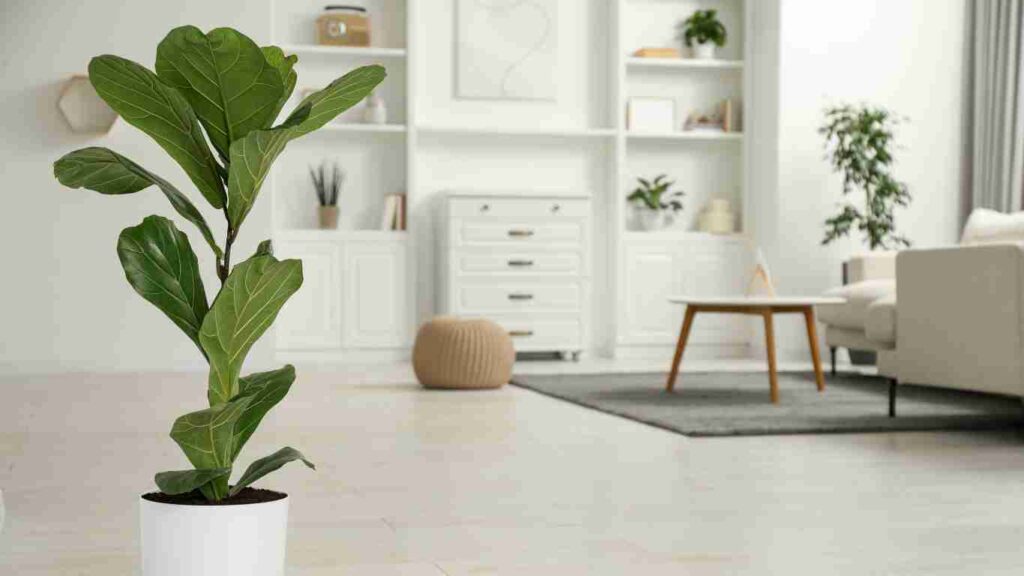Ultimate Guide to Growing and Caring for Fiddle Leaf Fig Plants Indoors

The fiddle leaf fig (Ficus lyrata) has a reputation for being a bit finicky, but its stunning large leaves and elegant tree-like shape make it worth the effort. Although it’s not the easiest houseplant to manage, it is a great option for beginners. These small trees thrive in indoor conditions with filtered light and consistent temperatures, tolerating less-than-perfect care.
If you have a window that gets bright morning light, you can successfully grow this plant. Use quality soil, stick to a regular watering schedule, and watch it grow to 6–10 feet tall without much hassle. However, keep in mind that fiddle leaf figs are toxic to both humans and pets.
Fiddle Leaf Fig Care Tips:
- Place the plant near a window to receive filtered or indirect light.
- Use premium houseplant soil and repot young plants annually.
- Water moderately to keep the soil evenly moist, but avoid over-watering.
- Support the main stem if necessary.
- Rotate the pot regularly to ensure even light exposure for all foliage.
- Wipe the leaves with a damp cloth every few weeks to improve photosynthesis.
How Much Light Do Fiddle Leaf Figs Need?
Fiddle leaf figs prefer bright, indirect light for about six hours daily. While they adapt to lower light, growth slows, and brown spots may develop on lower leaves. Avoid direct sunlight, particularly in west-facing windows, as it can scorch the leaves. If your plant is in low light, adjust the watering schedule to prevent over-watering issues.
What Kind of Potting Soil Is Best?
Choose a well-draining potting mix for indoor plants. A peat-based mix combined with perlite or a 50:50 blend of cactus and houseplant soil works well. Good drainage is essential to keep the roots healthy.
How Often Should You Water a Fiddle Leaf Fig?
Water your fiddle leaf fig when the top inch of soil feels dry. Insufficient water causes leaves to wilt and lose their vibrant green colour, while over-watering can lead to root rot and leaf drop. Flush the soil monthly to remove salt buildup caused by fertilizers or treated water.
Temperature and Humidity Requirements
Fiddle leaf figs thrive in household temperatures between 15°C and 29°C (60°F–85°F) with humidity levels of 30%–65%. Ensure good air circulation around the plant, and consider using a humidifier during dry winter months.
Should You Fertilize Fiddle Leaf Figs?
Yes, feed your fiddle leaf fig monthly during the growing season with a high-nitrogen fertilizer (e.g., NPK 16-5-11). Water-soluble or liquid fertilizers specifically designed for fiddle leaf figs work well.
Popular Fiddle Leaf Fig Varieties
- Ficus lyrata ‘Bambino’: A dwarf variety reaching only a few feet tall.
- Ficus lyrata ‘Compacta’: Grows up to 5 feet with denser foliage.
- Ficus lyrata ‘Variegata’: Features striking green and cream variegated leaves.
Tips for Selecting a Healthy Plant
- Inspect the undersides of leaves for moving red dots, which indicate spider mites.
- Avoid plants with many brown spots, as these won’t recover.
- Check the pot for standing water, which could signal root rot.
Pruning a Fiddle Leaf Fig
Selective pruning promotes healthy growth and a tree-like shape. Prune in late spring or summer using sharp tools, cutting at a 45-degree angle above a leaf node. To encourage branching, wait until the plant reaches 5 feet, then trim the main trunk. Regularly remove dead leaves and trim damaged edges for a neat appearance.
Note: Fiddle leaf figs release a milky sap when cut, which can irritate the skin. Wear gloves and clean cuts with a damp cloth.
Propagation: How to Grow Fiddle Leaf Figs From Cuttings
You can propagate fiddle leaf figs using stem cuttings in water or soil.
Water Propagation:
- Cut a branch with at least three leaf nodes at a 45-degree angle above a node.
- Remove lower leaves, leaving one or two at the top.
- Place the cutting in room-temperature water, ensuring nodes are submerged.
- Position the cutting in bright, indirect light. Change the water weekly.
- Transplant into soil once roots are 1–2 inches long.
Soil Propagation:
- Follow the first two steps above, then dip the cutting into rooting hormone.
- Plant in well-draining soil and cover with a plastic bag to retain humidity.
- Place in bright, indirect light, and check for root growth after two weeks.
Potting and Repotting Fiddle Leaf Figs
Repot young fiddle leaf figs annually in spring, choosing a pot 5 cm (2 inches) larger in diameter than the current one. Mature plants can remain in the same pot, but replace the top layer of soil each year.
Tip: If using a decorative pot without drainage, plant in a plastic liner pot and ensure no water accumulates at the bottom.
Common Pests and Diseases
Fiddle leaf figs are generally resilient but may attract pests like spider mites, scale, or mealybugs. Use neem oil or horticultural sprays to manage infestations. Root rot, caused by over-watering, is another common issue—watch for dark spots or mushy roots.
Troubleshooting Common Problems:
- Bleached Leaves: Indicates too much direct sunlight; move to filtered light.
- Brown Spots: Suggest root rot or inconsistent watering; prune damaged areas and adjust care.
- Yellow Leaves: May point to bacterial infections; isolate the plant and replace the soil.
- Leaf Drop: Often due to low light or temperature fluctuations; relocate to a stable environment.
FAQs
Are fiddle leaf figs low-maintenance?
While they require some effort, fiddle leaf figs thrive with proper care, including warmth, humidity, bright light, and regular watering.
Do fiddle leaf figs grow well indoors?
Yes, they are ideal for indoor spaces, offering a dramatic tree-like appearance without needing extensive gardening skills.
Can fiddle leaf figs tolerate direct sunlight?
No, these plants prefer bright, indirect light. Direct sun can cause leaf burn. Use filtered light for the best results.
If you have any other questions on your mind, feel free to ask here!